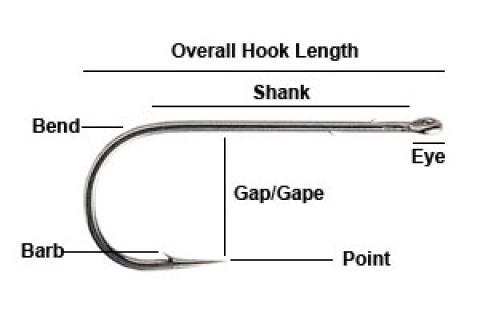
Hooks are an important part of your angling arsenal. This guide breaks down the common terms used to describe fish hooks, and what they mean. This is important information to know so you can make informed purchases when it's time to stock-up with hooks to cover a range of fishing scenarios.
Anatomy of a Fishing Hook
 All hooks have an eye, shank, gap, point and barb, but variations of these characteristics result in dozens of hook styles.
All hooks have an eye, shank, gap, point and barb, but variations of these characteristics result in dozens of hook styles.
The Eye — The hook eye is the connection point to the fishing line or the body of a lure. Ringed eyes are the most common. The metal is bent in a uniform loop and the end sits flush against the shank. Needle, looped and tapered are some other types of hook eyes, but they tend to be used for specific applications, like saltwater or dry flies.
The Shank — The shank is the section from the eye to where the bend starts. Shanks come in short, medium or long lengths, and are a major influence of how a hook is used. Short ones are often used for finesse fishing when a compact hook and minimal weight are critical to a successful presentation, like micro plastic smallmouth tactics or live bait fishing with a leech. Medium shanks are the most common and used in an array of fishing situations. Long shanks are used to match a longer profile of an artificial bait (like a spinnerbait or big plastic).
The Gap — The gap is the size of the bend in a hook from the shank to its point. An average size gap will do in most situations, but sometimes a wide gap is needed. A wide gap is used for rigging thick-bodied lures to ensure that the hook point will be exposed on the hook set, and not limited by the bait's bulk.
The Point — This is the tapered end of the hook and the sharp point that penetrates a fish's mouth. Shapes vary — needle, knife edge, spear or rolled are some examples. It's critical to keep points sharp, so invest in a file and use it often. Quality hooks are packaged extremely sharp and will keep a point longer than cheaper ones.
The Barb — The barb is designed to hold the hook in place once it penetrates the fish's mouth. The larger the barb, the more difficult it is for the fish (and likely yourself) to get the hook free. Many catch and release anglers pinch barbs with pliers or file them down for easy hook removal.
Each component of a hook plays an important role in catching a fish. Understanding shank length, gap, bend, and so on, will help you choose the best hook for rigging. It will also help you tailor a specific presentation for the day's conditions so you can catch more fish.
![]() Also Read: Fish Hook Removal and Injury Prevention
Also Read: Fish Hook Removal and Injury Prevention
![]() Also Read: A Simple Guide to the Most Popular Hook Styles
Also Read: A Simple Guide to the Most Popular Hook Styles
Also Read: A Guide to Specialty Fish Hooks and How to Use Them![]()

- 14190 views

